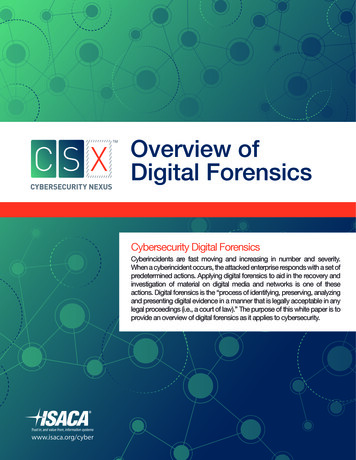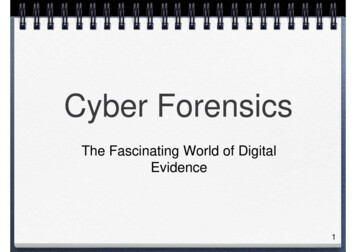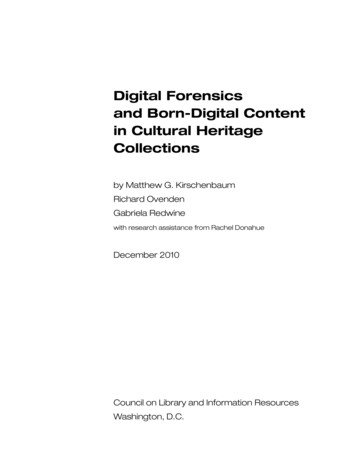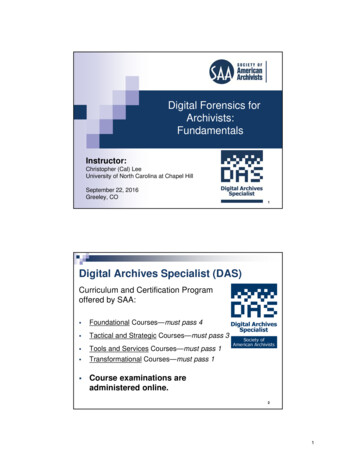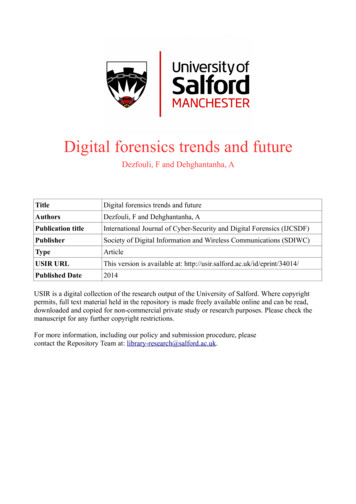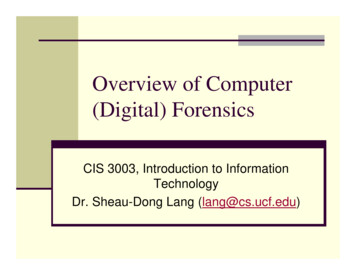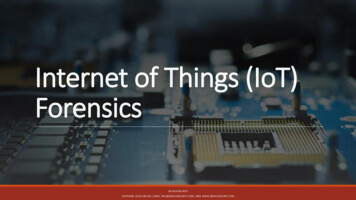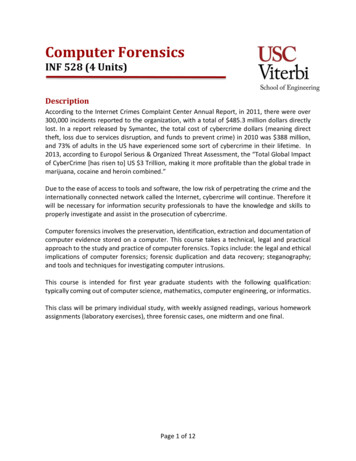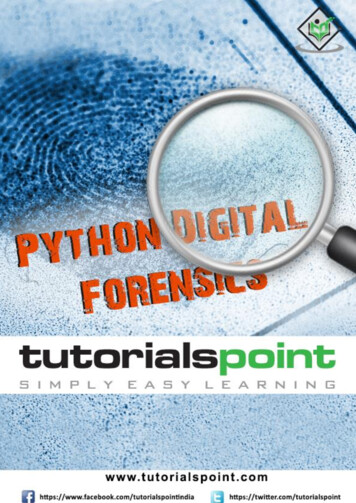
Transcription
Python Digital Forensics
Python Digital ForensicsAbout the TutorialDigital forensics is the branch of forensic science that analyzes, examines, identifies aswell as recovers the digital evidences from electronic devices. It is commonly used incriminal law and private investigation. This tutorial will make you comfortable withperforming Digital Forensics in Python on Windows operated digital devices. In this tutorial,you will learn various concepts and coding for carrying out digital forensics in Python.AudienceThis tutorial will be useful for graduates, post graduates, and research students who eitherhave an interest in this subject or have this subject as a part of their curriculum. Anyreader who is enthusiastic about gaining knowledge digital forensics using Pythonprogramming language can also pick up this tutorial.PrerequisitesThis tutorial is designed by making an assumption that the reader has a basic knowledgeabout operating system and computer networks. You are expected to have a basicknowledge of Python programming.If you are novice to any of these subjects or concepts, we strongly suggest you go throughtutorials based on these, before you start your journey with this tutorial.Copyright & Disclaimer Copyright 2018 by Tutorials Point (I) Pvt. Ltd.All the content and graphics published in this e-book are the property of Tutorials Point (I)Pvt. Ltd. The user of this e-book is prohibited to reuse, retain, copy, distribute or republishany contents or a part of contents of this e-book in any manner without written consentof the publisher.We strive to update the contents of our website and tutorials as timely and as precisely aspossible, however, the contents may contain inaccuracies or errors. Tutorials Point (I) Pvt.Ltd. provides no guarantee regarding the accuracy, timeliness or completeness of ourwebsite or its contents including this tutorial. If you discover any errors on our website orin this tutorial, please notify us at contact@tutorialspoint.comi
Python Digital ForensicsTable of ContentsAbout the Tutorial . iAudience . iPrerequisites . iCopyright & Disclaimer. iTable of Contents . ii1.PYTHON DIGITAL FORENSICS — INTRODUCTION. 1What is Digital Forensics?. 1Brief Historical Review of Digital Forensics . 1Process of Digital Forensics . 2Applications of Digital Forensics . 3Branches of Digital Forensics . 3Skills Required for Digital Forensics Investigation . 4Limitations . 42.PYTHON DIGITAL FORENSICS – GETTING STARTED WITH PYTHON . 6Why Python for Digital Forensics? . 6Features of Python . 6Installing Python . 7Setting the PATH . 8Running Python . 93.PYTHON DIGITAL FORENSICS – ARTIFACT REPORT. 10Need of Report Creation . 10General Guidelines for Report Creation . 10Creating Different Type of Reports . 11Investigation Acquisition Media . 13ii
Python Digital Forensics4.PYTHON DIGITAL FORENSICS – MOBILE DEVICE FORENSICS . 15Introduction . 15Artifacts Extractible from Mobile Devices . 15Evidence Sources and Processing in Python . 15iTunes Backups. 17Wi - Fi . 225.PYTHON DIGITAL FORENSICS – INVESTIGATING EMBEDDED METADATA . 28Introduction . 28Artifacts Containing Metadata Attributes and their Extraction . 286.PYTHON DIGITAL FORENSICS – NETWORK FORENSICS-I . 40Understanding Network Forensics . 40Internet Evidence Finder (IEF) . 40Use of IEF . 40Dumping Reports from IEF to CSV using Python . 417.PYTHON DIGITAL FORENSICS – NETWORK FORENSICS-II . 47Web Page Preservation with Beautiful Soup . 47What is Beautiful Soup? . 47Python Script for Preserving Web Pages . 48Virus Hunting . 52Understanding VirusShare. 52Creating Newline-Delimited Hash List from VirusShare using Python . 538.PYTHON DIGITAL FORENSICS – INVESTIGATION USING EMAILS. 56Role of Email in Investigation . 56Challenges in Email Forensics . 56Techniques Used in Email Forensic Investigation . 57iii
Python Digital ForensicsExtraction of Information from EML files . 57Analyzing MSG Files using Python . 59Structuring MBOX files from Google Takeout using Python . 63Acquiring Google Account Mailbox into MBX Format. 639.PYTHON DIGITAL FORENSICS – IMPORTANT ARTIFACTS IN WINDOWS-I. 68Introduction . 68Importance of Windows Artifacts for Forensics . 68Windows Artifacts and their Python Scripts . 6810. PYTHON DIGITAL FORENSICS – IMPORTANT ARTIFACTS IN WINDOWS-II. 79User Activities . 79LINK files . 84Prefetch Files. 8611. PYTHON DIGITAL FORENSICS – IMPORTANT ARTIFACTS IN WINDOWS-III . 91Event Logs . 91Internet History . 95Volume Shadow Copies . 9912. PYTHON DIGITAL FORENSICS – INVESTIGATION OF LOG BASED ARTIFACTS . 103Introduction . 103Various Log-based Artifacts and Investigating in Python . 103Timestamps. 103Web Server Logs. 106Scanning Important Files using YARA . 109iv
1. Python Digital Forensics — IntroductionPython Digital ForensicsThis chapter will give you an introduction to what digital forensics is all about, and its historicalreview. You will also understand where you can apply digital forensics in real life and itslimitations.What is Digital Forensics?Digital forensics may be defined as the branch of forensic science that analyzes, examines,identifies and recovers the digital evidences residing on electronic devices. It is commonlyused for criminal law and private investigations.For example, you can rely on digital forensics extract evidences in case somebody steals somedata on an electronic device.Brief Historical Review of Digital ForensicsThe history of computer crimes and the historical review of digital forensics is explained inthis section as given below:1970s-1980s: First Computer CrimePrior to this decade, no computer crime has been recognized. However, if it is supposed tohappen, the then existing laws dealt with them. Later, in 1978 the first computer crime wasrecognized in Florida Computer Crime Act, which included legislation against unauthorizedmodification or deletion of data on a computer system. But over the time, due to theadvancement of technology, the range of computer crimes being committed also increased.To deal with crimes related to copyright, privacy and child pornography, various other lawswere passed.1980s-1990s: Development DecadeThis decade was the development decade for digital forensics, all because of the first everinvestigation (1986) in which Cliff Stoll tracked the hacker named Markus Hess. During thisperiod, two kind of digital forensics disciplines developed – first was with the help of ad-hoctools and techniques developed by practitioners who took it as a hobby, while the secondbeing developed by scientific community. In 1992, the term “Computer Forensics” wasused in academic literature.2000s-2010s: Decade of StandardizationAfter the development of digital forensics to a certain level, there was a need of making somespecific standards that can be followed while performing investigations. Accordingly, variousscientific agencies and bodies have published guidelines for digital forensics. In 2002,Scientific Working Group on Digital Evidence (SWGDE) published a paper named “Best1
Python Digital Forensicspractices for Computer Forensics”.Another feather in the cap was a European ledinternational treaty namely “The Convention on Cybercrime” was signed by 43 nationsand ratified by 16 nations. Even after such standards, still there is a need to resolve someissues which has been identified by researchers.Process of Digital ForensicsSince first ever computer crime in 1978, there is a huge increment in digital criminal activities.Due to this increment, there is a need for structured manner to deal with them. In 1984, aformalized process has been introduced and after that a great number of new and improvedcomputer forensics investigation processes have been developed.A computer forensics investigation process involves three major phases as explained below:Phase 1: Acquisition or Imaging of ExhibitsThe first phase of digital forensics involves saving the state of the digital system so that it canbe analyzed later. It is very much similar to taking photographs, blood samples etc. from acrime scene. For example, it involves capturing an image of allocated and unallocated areasof a hard disk or RAM.Phase 2: AnalysisThe input of this phase is the data acquired in the acquisition phase. Here, this data wasexamined to identify evidences. This phase gives three kinds of evidences as follows: Inculpatory evidences: These evidences support a given history. Exculpatory evidences: These evidences contradict a given history. Evidence of tampering: These evidences show that the system was tempered to avoididentification. It includes examining the files and directory content for recovering thedeleted files.Phase 3: Presentation or ReportingAs the name suggests, this phase presents the conclusion and corresponding evidences fromthe investigation.2
Python Digital ForensicsApplications of Digital ForensicsDigital forensics deals with gathering, analyzing and preserving the evidences that arecontained in any digital device. The use of digital forensics depends on the application. Asmentioned earlier, it is used mainly in the following two applications:Criminal LawIn criminal law, the evidence is collected to support or oppose a hypothesis in the court.Forensics procedures are very much similar to those used in criminal investigations but withdifferent legal requirements and limitations.Private InvestigationMainly corporate world uses digital forensics for private investigation. It is used whencompanies are suspicious that employees may be performing an illegal activity on theircomputers that is against company policy. Digital forensics provides one of the best routesfor company or person to take when investigating someone for digital misconduct.Branches of Digital ForensicsThe digital crime is not restricted to computers alone, however hackers and criminals areusing small digital devices such as tablets, smart-phones etc. at a very large scale too. Someof the devices have volatile memory, while others have non-volatile memory. Hencedepending upon type of devices, digital forensics has the following branches:Computer ForensicsThis branch of digital forensics deals with computers, embedded systems and static memoriessuch as USB drives. Wide range of information from logs to actual files on drive can beinvestigated in computer forensics.Mobile ForensicsThis deals with investigation of data from mobile devices. This branch is different fromcomputer forensics in the sense that mobile devices have an inbuilt communication systemwhich is useful for providing useful information related to location .Network ForensicsThis deals with the monitoring and analysis of computer network traffic, both local andWAN(wide area network) for the purposes of information gathering, evidence collection, orintrusion detection.Database ForensicsThis branch of digital forensics deals with forensics study of databases and their metadata.3
Python Digital ForensicsSkills Required for Digital Forensics InvestigationDigital forensics examiners help to track hackers, recover stolen data, follow computer attacksback to their source, and aid in other types of investigations involving computers. Some ofthe key skills required to become digital forensics examiner as discussed below:Outstanding Thinking CapabilitiesA digital forensics investigator must be an outstanding thinker and should be capable ofapplying different tools and methodologies on a particular assignment for obtaining theoutput. He/she must be able to find different patterns and make correlations among them.Technical SkillsA digital forensics examiner must have good technological skills because this field requiresthe knowledge of network, how digital system interacts.Passionate about Cyber SecurityBecause the field of digital forensics is all about solving cyber-crimes and this is a tedioustask, it needs lot of passion for someone to become an ace digital forensic investigator.Communication SkillsGood communication skills are a must to coordinate with various teams and to extract anymissing data or information.Skillful in Report MakingAfter successful implementation of acquisition and analysis, a digital forensic examiner mustmention all the findings the final report and presentation. Hence he/she must have good skillsof report making and an attention to detail.LimitationsDigital forensic investigation offers certain limitations as discussed here:Need to produce convincing evidencesOne of the major setbacks of digital forensics investigation is that the examiner must have tocomply with standards that are required for the evidence in the court of law, as the data canbe easily tampered. On the other hand, computer forensic investigator must have completeknowledge of legal requirements, evidence handling and documentation procedures topresent convincing evidences in the court of law.Investigating ToolsThe effectiveness of digital investigation entirely lies on the expertise of digital forensicsexaminer and the selection of proper investigation tool. If the tool used is not according tospecified standards then in the court of law, the evidences can be denied by the judge.4
Python Digital ForensicsLack of technical knowledge among the audienceAnother limitation is that some individuals are not completely familiar with computerforensics; therefore, many people do not understand this field. Investigators have to be sureto communicate their findings with the courts in such a way to help everyone understand theresults.CostProducing digital evidences and preserving them is very costly. Hence this process may notbe chosen by many people who cannot afford the cost.5
2. Python Digital Forensics – Getting Started withPythonPython Digital ForensicsIn the previous chapter, we learnt the basics of digital forensics, its advantages andlimitations. This chapter will make you comfortable with Python, the essential tool that we areusing in this digital forensics investigation.Why Python for Digital Forensics?Python is a popular programming language and is used as tool for cyber security, penetrationtesting as well as digital forensic investigations. When you choose Python as your tool fordigital forensics, you do not need any other third party software for completing the task.Some of the unique features of Python programming language that makes it a good fit fordigital forensics projects are given below: Simplicity of Syntax: Python’s syntax is simple compared to other languages, thatmakes it easier for one to learn and put into use for digital forensics. Comprehensive inbuilt modules: Python’s comprehensive inbuilt modules are anexcellent aid for performing a complete digital forensic investigation. Help and Support: Being an open source programming language, Python enjoysexcellent support from the developer’s and users’ community.Features of PythonPython, being a high-level, interpreted, interactive and object-oriented scripting language,provides the following features: Easy to Learn: Python is a developer friendly and easy to learn language, because ithas fewer keywords and simplest structure. Expressive and Easy to read: Python language is expressive in nature; hence itscode is more understandable and readable. Cross-platform Compatible: Python is a cross-platform compatible language whichmeans it can run efficiently on various platforms such as UNIX, Windows, andMacintosh. Interactive Mode Programming: We can do interactive testing and debugging ofcode because Python supports an interactive mode for programming. Provides Various Modules and Functions: Python has large standard library whichallows us to use rich set of modules and functions for our script.6
Python Digital Forensics Supports Dynamic Type Checking: Python supports dynamic type checking andprovides very high-level dynamic data types. GUI Programming: Python supports GUI programming to develop Graphical userinterfaces. Integration with other programming languages: Python can be easily integratedwith other programming languages like C, C , JAVA etc.Installing PythonPython distribution is available for various platforms such as Windows, UNIX, Linux, and Mac.We only need to download the binary code as per our platform. In case if the binary code forany platform is not available, we must have a C compiler so that source code can be compiledmanually.This section will make you familiar with installation of Python on various platforms:Python Installation on Unix and LinuxYou can follow following the steps shown below to install Python on Unix/Linux machine.Step1: Open a Web browser. Type and enter https://www.python.org/downloads/.Step2: Download zipped source code available for Unix/Linux.Step3: Extract the downloaded zipped files.Step4: If you wish to customize some options, you can edit the Modules/Setup file.Step5: Use the following commands for completing the installation:run ./configure scriptmakemake installOnce you have successfully completed the steps given above, Python will be installed at itsstandard location /usr/local/bin and its libraries at /usr/local/lib/pythonXX where XXis the version of Python.Python Installation on WindowsWe can follow following simple steps to install Python on Windows machine.Step1: Open a web browser. Type and enter https://www.python.org/downloads/.Step2: Download the Windows installer python-XYZ.msi file, where XYZ is the version weneed to install.Step3: Now run that MSI file after saving the installer file to your local machine.7
Python Digital ForensicsStep4: Run the downloaded file which will bring up the Python installation wizard.Python Installation on MacintoshFor installing Python 3 on Mac OS X, we must use a package installer named Homebrew.You can use the following command to install Homebrew, incase you do not have it on yoursystem: ruby -e " (curl stall/master/install)"If you need to update the package manager, then it can be done with the help of followingcommand: brew updateNow, use the following command to install Python3 on your system: brew install python3Setting the PATHWe need to set the path for Python installation and this differs with platforms such as UNIX,WINDOWS, or MAC.Path setting at Unix/LinuxYou can use the following options to set the path on Unix/Linux: If using csh shell- Type setenv PATH " PATH:/usr/local/bin/python" and thenpress Enter. Ifusingbashshell(Linux) TypeATH " PATH:/usr/local/bin/python" and then press Enter. If using sh or ksh shell Type PATH " PATH:/usr/local/bin/python" andthen press Enter.exportPath Setting at WindowsType path %path%;C:\Python at the command prompt and then press Enter.8
Python Digital ForensicsRunning PythonYou can choose any of the following three methods to start the Python interpreter:Method 1: Using Interactive InterpreterA system that provides a command-line interpreter or shell can easily be used for startingPython. For example, Unix, DOS etc. You can follow the steps given below to start coding ininteractive interpreter:Step1: Enter python at the command line.Step2: Start coding right away in the interactive interpreter using the commands shownbelow: python # Unix/Linuxorpython% # Unix/LinuxorC: python # Windows/DOSMethod 2: Using Script from the Command-lineWe can also execute a Python script at command line by invoking the interpreter on ourapplication. You can use commands shown below: python script.py # Unix/Linuxorpython% script.py # Unix/LinuxorC: python script.py # Windows/DOSMethod 3. Integrated Development EnvironmentIf a system has GUI application that supports Python, then Python can be run from that GUIenvironment. Some of the IDE for various platforms are given below: Unix IDE: UNIX has IDLE IDE for Python. Windows IDE: Windows has PythonWin, the first Windows interface for Python alongwith GUI. Macintosh IDE: Macintosh has IDLE IDE which is available from the main website,downloadable as either MacBinary or BinHex'd files.9
3. Python Digital Forensics – Artifact ReportPython Digital ForensicsNow that you are comfortable with installation and running Python commands on your localsystem, let us move into the concepts of forensics in detail. This chapter will explain variousconcepts involved in dealing with artifacts in Python digital forensics.Need of Report CreationThe process of digital forensics includes reporting as the third phase. This is one of the mostimportant parts of digital forensic process. Report creation is necessary due to the followingreasons: It is the document in which digital forensic examiner outlines the investigation processand its findings. A good digital forensic report can be referenced by another examiner to achieve sameresult by given same repositories. It is a technical and scientific document that contains facts found within the 1s and 0sof digital evidence.General Guidelines for Report CreationThe reports are written to provide information to the reader and must start with a solidfoundation. investigators can face difficulties in efficiently presenting their findings if thereport is prepared without some general guidelines or standards. Some general guidelineswhich must be followed while creating digital forensic reports are given below: Summary: The report must contain the brief summary of information so that thereader can ascertain the report’s purpose. Tools used: We must mention the tools which have been used for carrying the processof digital forensics, including their purpose. Repository: Suppose, we investigated someone’s computer then the summary ofevidence and analysis of relevant material like email, internal search history etc., thenthey must be included in the report so that the case may be clearly presented. Recommendations for counsel: The report must have the recommendations forcounsel to continue or cease investigation based on the findings in report.10
Python Digital ForensicsCreating Different Type of ReportsIn the above section, we came to know about the importance of report in digital forensicsalong with the guidelines for creating the same. Some of the formats in Python for creatingdifferent kind of reports are discussed below:CSV ReportsOne of the most common output formats of reports is a CSV spreadsheet report. You cancreate a CSV to create a report of processed data using the Python code as shown below:First, import useful libraries for writing the spreadsheet:from future import print functionimport csvimport osimport sysNow, call the following method:Write csv(TEST DATA LIST, ["Name", "Age", "City", "Job description"], os.getcwd())We are using the following global variable to represent sample data types:TEST DATA LIST [["Ram", 32, Bhopal, Manager], ["Raman", 42, Indore,Engg.],["Mohan", 25, Chandigarh, HR], ["Parkash", 45, Delhi, IT]]Next, let us define the method to proceed for further oper
Python Digital Forensics 2 practices for Computer Forensics”. Another feather in the cap was a European led international treaty namely “The Convention on Cybercr

